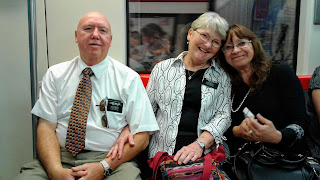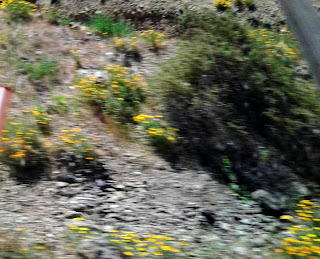November in the Southern Hemisphere
 |
| Some of the children are (and some aren't!) learning more about the temple: when they turn twelve they are qualified to perform baptisms and confirmations for deceased family and others who did not have the opportunity to perform these ordinances for themselves . |
Mid-November feels like mid-summer in Santiago: The jacaranda trees finish blooming, it still snows in the higher Andes, Christmas decorations, as well as strawberries, cherries, canteloup, watermelon, etc. have come to the stores, people wear shorts and complain about the heat, their allergies, talk of beach plans, and kids look forward to school being out for the summer by mid-December. The new school year begins about March 1. My English classes, which I enjoy so much, continue year-round, as does temple service except for two weeks coming up the end of January when it closes for maintenance.

 |
| The sculpture park along the river with Costanera Center looming into the sky, continues to have interesting exhibits. |
 |
Chile is so long that it is often presented in 2 parts (as on my map) northern on left, southern on right). The regions are numbered from top, originally part of Peru, before War of the Pacific (#1) to bottom (#15) [though some say only 7 basic regions]. (including the Easter Islands)
So climate, culture, etc. vary a lot! |
.......and while I've been working in the temple, turning on my air-conditioner, writing Holiday/Christmas newsletters, and thinking of all of you this ordinary week here, eating lots of turkey and pie.....
 |
| Kelly Taylor, Coco and Taffy Carlston, Olivia Absey-Allen |
Four of my siblings and families and three of my children and families gathered in San Diego, California, to celebrate Thanksgiving 2018.
I have been with them in spirit, right here in Santiago, grateful to know they are having fun together. What more can a mom ask for than family who love and care for each other, and will drive MANY miles to be together? All the kids (except tall Olivia in the center) are my grandchildren.
  |

Meanwhile, in Santiago, we all enjoy each other's company, too: Missionaries (above) leave the training center and go to the field, others come to the temple if they are serving within a certain distance. Hermana Zambrano from Esmeraldas, Ecuador, left the MTC a few days ago with her suitcase, and now she is serving in Santiago North with her new companion Sister Stenquist from Idaho Falls. (Below), the last group before the permanent closure of Santiago MTC, of Latino missionaries practice missionary skills on the temple grounds. Starting in January missionaries assigned to serve in Chile will go to other centers such as Lima, Bogota, Buenos Aires, Mexico, Utah |

The elder on the left is from Utah, the 2 sisters on the right are from Vancouver and Curitiba, Brazil, and others are from Spanish-speaking Latin America. All serve in Santiago North mission under President Bentley.
We also love all those who work in, around and behind the scenes at the temple,hostel, gardens, etc.
 |
|
 |
Security, cleaning and administrators help run the temple buildings. Lower above (center) are Hno. Zey, director of hostel and George, who makes everyone welcome, etc. Below is head of engineering, gardening, etc.
Hermano Canoles (below with the phone, is the man who gets things done=fixed! He made sure I got a new fridge, electricity repaired, a recliner and smaller bed)
Hno. Angulo (in the red tie below) is recorder in the temple (makes sure temple ordinances are recorded properly, and more) 
This week has been mostly about people, but I'm planning a trip on Monday to the mountains, so hopefully I'll have some interesting nature photos to share next week.
To conclude this week's post, I'd like to share with you a brief message delivered by Elder Neil Andersen in last month's General Conference:
"We search for happiness. We long for peace. We hope for love. And the Lord showers us with an amazing abundance of blessings. But intermingled with the joy and happiness, one thing is certain: there will be moments, hours, days, and sometimes years when your soul will be wounded.. [These are not unique to the rich or the poor, to one culture, one nation, or one generation, and can come from so many different sources and in so many ways; they are part of life]. Never give up, look forward. Your troubles and sorrows are very real, but they will not last forever."
Reach out to others. Be their angels. Most people put on a good face, but they may be lonely, depressed, stressed, afraid.
Look to Jesus Christ who heals broken hearts, when others may pass us by. Try it! It works! I know with all my heart it does!
As we enter the Christmas season, do something to bring light, comfort, and joy to others. Be creative! It can be simple, too.
|































































